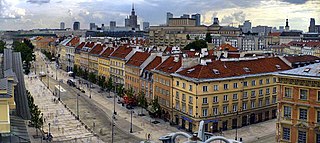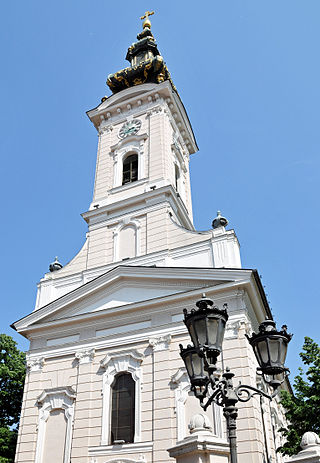The Polish Baroque lasted from the early 17th to the mid-18th century. As with Baroque style elsewhere in Europe, Poland's Baroque emphasized the richness and triumphant power of contemporary art forms. In contrast to the previous, Renaissance style which sought to depict the beauty and harmony of nature, Baroque artists strove to create their own vision of the world. The result was manifold, regarded by some critics as grand and dramatic, but sometimes also chaotic and disharmonious and tinged with affectation and religious exaltation, thus reflecting the turbulent times of the 17th-century Europe.

The Alexander Nevsky Cathedral was a Russian Orthodox Cathedral in Saxon Square built in Warsaw, Congress Poland, then a part of the Russian Empire. The cathedral was designed by the distinguished Russian architect Leon Benois, and was built between 1894 and 1912. When it was finally completed, it was 70 metres in height, at that time, the tallest building in Warsaw.

The Field Cathedral of the Polish Army is the main garrison church of Warsaw and the representative cathedral of the entire Polish Army. In the past the church served a variety of communities and roles: it used to be the church of the Collegium Nobilium and in the 19th century was also turned into a Russian Orthodox church. Currently all major military religious feasts in Warsaw are held there.

Miodowa is a street in Warsaw's Old Town. More precisely, it links the Krakowskie Street in with Krasiński Square. It is also the name of a street in the Kazimierz district in Kraków.

Krakowskie Przedmieście, often abbreviated to Krakowskie, is one of the best known and most prestigious streets of Poland's capital Warsaw, surrounded by historic palaces, churches and manor-houses. Krakowskie Przedmieście Royal Avenue constitutes the northernmost part of Warsaw's Royal Route, and links the Old Town and Royal Castle with some of the most notable institutions in Warsaw, including – proceeding southward – the Presidential Palace, Warsaw University, and the Polish Academy of Sciences headquartered in the Staszic Palace. The immediate southward extension of Krakowskie Przedmieście along the Royal Route is ulica Nowy Świat.

Belgrade, Serbia has an abundance of religious architecture. The city has numerous Serbian Orthodox churches and temples and it is also the seat of the Patriarch of the Serbian Orthodox Church. Its two most prominent Orthodox Christian places of worship are the Saborna Crkva and the Temple of St. Sava, the largest Eastern Orthodox church in the world.

Religious architecture in Novi Sad is very diverse. Majority of the believers in Novi Sad are from Serbian Orthodox Church, while others are from Roman Catholic Church, many Protestant churches, and Jewish community. Stari Grad is the place with the majority of churches and temples, and they were all built in the 18th and 19th century.

Religion in Poland is rapidly declining, although historically it had been one of the most Catholic countries in the world.

The Church of the Holy Cross is a Roman Catholic house of worship in Warsaw, Poland. Located on Krakowskie Przedmieście opposite the main Warsaw University campus, it is one of the most notable Baroque churches in Poland's capital.
Holy Cross Church, or variants thereof, may refer to:

Church of St. Joseph of the Visitationists commonly known as the Visitationist Church is a Roman Catholic church in Warsaw, Poland, situated at Krakowskie Przedmieście 34. One of the most notable rococo churches in Poland's capital, its construction was begun in 1664 and completed in 1761.

The architecture of Poland includes modern and historical monuments of architectural and historical importance.

St. Florian's Cathedral, more formally known as the Cathedral of St. Michael the Archangel and St. Florian the Martyr, is a Roman Catholic church and minor basilica, dedicated to St. Florian. The church is located at 3 Floriańska Street in Praga-Północ district of Warsaw.

The Metropolitan Cathedral of the Holy and Equal-to-the-Apostles Mary Magdalene is a Polish Orthodox cathedral, located at al. Solidarności 52 in Warsaw.

The Pancer Viaduct was a viaduct in Warsaw joining Castle Square to the Kierbedzia Bridge. It was built in 1846, and demolished in 1944 and was replaced by the Warsaw W-Z Route thoroughfare.

Józef Fontana II was a Swiss Italian Polish architect and the father of architects, Jakub Fontana and Jan Kanty Fontana.

The Four Denominations District is an area of the Old Town in Wrocław, Poland, between Kazimierza Wielkiego, Sw. Antoniego, Pawła Włodkowica and Sw. Mikolaja streets. The name has been used since 1995 on the initiative of Christian clergy together with Jerzy Kichler, an activist from the Polish Jewish community.















